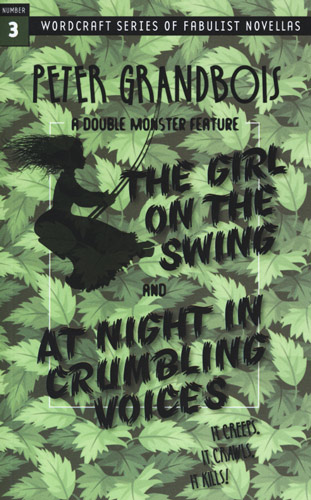The Girl on the Swing and At Night in Crumbling Voices
“The Girl on the Swing,” the first novella of this two-story collection by Peter Grandbois, fittingly opens with a Kafka quote, because this is very much a story of metamorphosis. Not only does “the girl,” timid but precocious twelve-year-old Isabel, undergo a dramatic physical transformation, but so do the other three members of her family: her mother, father, and her brother, each in their own unsettling way. Isabel’s dramatic and quite gruesome transformation triggers a domino effect throughout the family; the panic caused by her transformation highlights her family’s dysfunction, which soon snowballs into a full-blown collapse. “The Girl on the Swing,” the first novella of this two-story collection by Peter Grandbois, fittingly opens with a Kafka quote, because this is very much a story of metamorphosis. Not only does “the girl,” timid but precocious twelve-year-old Isabel, undergo a dramatic physical transformation, but so do the other three members of her family: her mother, father, and her brother, each in their own unsettling way. Isabel’s dramatic and quite gruesome transformation triggers a domino effect throughout the family; the panic caused by her transformation highlights her family’s dysfunction, which soon snowballs into a full-blown collapse.
The destruction of the family starts when Isabel’s father notices a wound on her hand. Isabel loses her sense of self, becoming distant, and also becoming cynical of her parents:
“You’re not my daddy,” she said.
Twelve year olds can have a strange sense of humor. He waited for her to laugh, to crack a smile. Nothing.
The way Isabel’s “condition” should be dealt with begins to pull the spouses apart—the father thinks drastic measures should be taken, at one point resolving to cut through Isabel’s infected hand with a pair of garden shears (!), whereas the mother simply thinks the father is worrying too much, and that he is giving Isabel too much attention, something Isabel secretly desires from them.
This story is about the change of Isabel’s family as much as it is about a quite literal transformation of Isabel. This is a story of a family’s complete collapse, and Grandbois constructs it in such a skillful way that by the time the story is over, I too felt crushed.
The second novella of the book is “At Night in Crumbling Voices,” a hybrid-genre story that combines elements of mystery, sci-fi, and “literary” fiction. It revolves around the “myth” of a secret society known as “the mole people,” who may or may not actually exist, often coming to the story’s various characters in the middle of the night, whispering things to them when these characters are the most vulnerable.
This story shifts types of narration and POVs constantly, between journalistic, scholarly “lectures” regarding the findings and studies regarding the mole people, and abstract, poetic segments narrated by the mole people to various characters, to narrations by the characters themselves. Grandbois’s juggling of narrative styles throughout this story at times proved effective, or at the very least interesting, but at the same time it made it difficult to get into a “rhythm” as a reader.
The “nonfiction” element of this story (the lectures and studies) adds a layer of authority to the mythos surrounding the mole people, but to me it also distracts from the action of the story:
Dr. Abe’s current theoretical work proposes that it is precisely this fear that leads to our secret desire to enslave them. In his seminal paper entitled, “Of Slaves and Skyscrapers: Why We Need Heroes,” published in American Anthropologist in 2006, he posits the prevalence of superheroes in modern movies, video games, and comic books as a desperate attempt to keep the mole people at bay.
This writing style sharply cuts to the beautiful and poetic narrations of the mole people:
The spiral-shaped life began with a kiss, a kiss in a garden, a garden in a park at night beneath dark stars. What thin-skinned redemption! If you try to walk your way out of the shell, say on your breath, your skin bleeds a thousand cuts.
The story’s brilliant premise gets muddied at times with over-explanation, or with an attempt at elaboration, when I think that less would’ve been more effective. Though overall, “At Night in Crumbling Voices” is a beautiful and haunting story, showing us that we are our own antagonists, and that our pasts never truly leave us.
Grandbois’s two tales here are carefully crafted tales of family, of betrayal, and of suffering. Grandbois uses a multitude of narrative techniques that often immersed me in the stories in ways I hadn’t anticipated. Though sometimes the stories felt a bit overdone—by this I mean told from too many different angles—the experimental nature of these two stories never overshadows their raw emotion, their energy, and their breathtaking, poetic prose.





